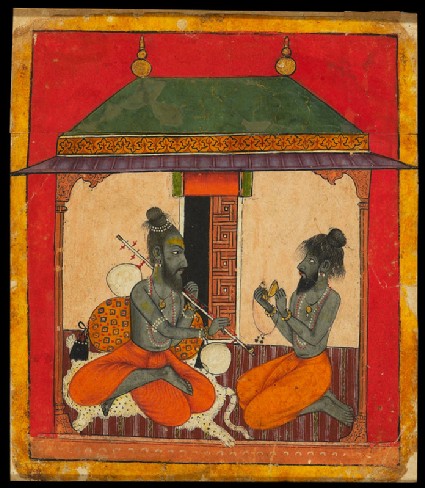Search Results: objects
Show search helpAscetics making music, illustrating the musical mode Kedara Raga
- loan
-
Description
The musical mode Kedara is visualised as two yogis or ascetics making music within a small pavilion. Seated on a leopard skin, a traditional seat of yogis who have mastered the temptations of the sensual world, the vina player improvises a raga, gazing with concentration at his companion who beats the tala or rhythmic cycle with cymbals.
-
Details
- Series
- Garland of Ragas
- Associated place
-
Asia › India › north-west India › Punjab Hills › Himachal Pradesh › Arki (probable place of creation)
- Date
- late 17th century
- Material and technique
- gouache on paper
- Dimensions
-
frame 29.6 x 26.2 x 1.5 cm (height x width x depth)
painting 21.2 x 18.2 cm (height x width)
- Material index
- Technique index
- Object type index
- No. of items
- 1
- Credit line
- Lent by Howard Hodgkin.
- Accession no.
- LI118.87
-
Further reading
Oxford: Ashmolean Museum, 2nd February-22nd April 2012, Visions of Mughal India: The Collection of Howard Hodgkin, Andrew Topsfield, ed. (Oxford: Ashmolean Museum, 2012), no. 59 on p. 142, pp. 18 & 19, illus. p. 143
Glossary
Raga
-
Raga
Raga (feminine ragini) are musical modes, often represented by compositions of ladies, lovers, warriors, animals or gods, in series of Ragamala ('Garland of Ragas') paintings, a very popular artistic genre in north India and the Deccan c. 1500 - 1800.
Past Exhibition
see (1)Location
-
- Returned to lender
Objects are sometimes moved to a different location. Our object location data is usually updated on a monthly basis. Contact the Jameel Study Centre if you are planning to visit the museum to see a particular object on display, or would like to arrange an appointment to see an object in our reserve collections.
© 2013 University of Oxford - Ashmolean Museum


